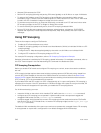
requirement for point-to-point connections by creating a unique virtual link for each connection
between an FCoE end-device and an FCF via a transit switch.
FIP provides functionality for discovering and logging into an FCF. After discovering and logging in, FIP
allows FCoE traffic to be sent and received between FCoE end-devices (ENodes) and the FCF. FIP uses its
own EtherType and frame format. The following illustration shows the communication that occurs
between an ENode server and an FCoE switch (FCF).
The following table lists the FIP functions.
Table 19. FIP Functions
FIP Function Description
FIP VLAN discovery FCoE devices (ENodes) discover the FCoE VLANs
on which to transmit and receive FIP and FCoE
traffic.
FIP discovery FCoE end-devices and FCFs are automatically
discovered.
Initialization FCoE devices learn ENodes from the FLOGI and
FDISC to allow immediate login and create a virtual
link with an FCoE switch.
Maintenance A valid virtual link between an FCoE device and an
FCoE switch is maintained and the LOGO
functions properly.
Logout On receiving a FLOGI packet, FSB deletes all
existing sessions from the ENode to the FCF.
FCoE Transit
345


















